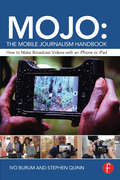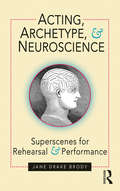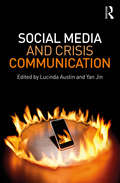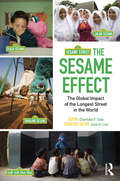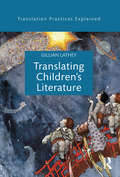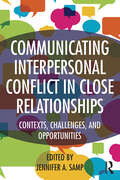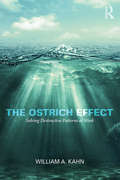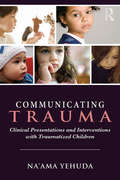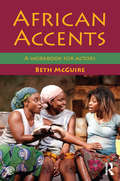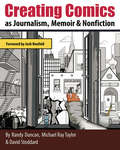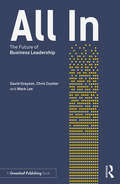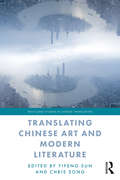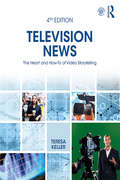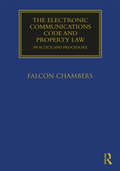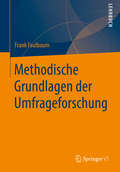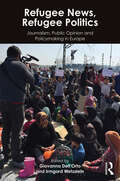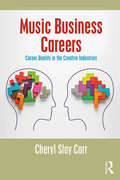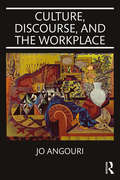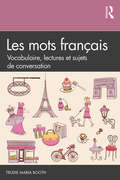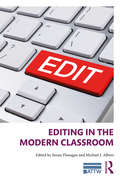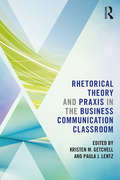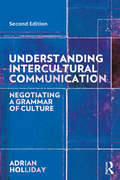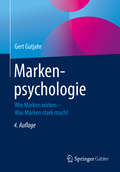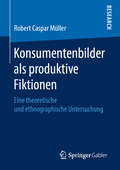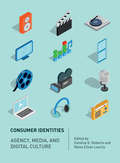- Table View
- List View
MOJO: How to Make Broadcast Videos with an iPhone or iPad
by Stephen Quinn Ivo BurumMOJO: The Mobile Journalism Handbook is the first book devoted specifically to training citizens, journalism students and media professionals to produce professional-quality videos with only a mobile device. As journalism becomes increasingly competitive, students and emerging professionals need a broader skillset to make themselves more employable, whether as mainstream or entrepreneurial journalists. This book by Dr. Ivo Burum and Dr. Stephen Quinn, world experts in mobile journalism, provides comprehensive coverage of all the skills and practices needed to be a mobile journalist. Key features: Burum and Quinn underline the importance of story and storytelling, the crucial context journalists always need to keep in mind. Other books and tutorials merely offer step-by-step guidance to mobile technology and apps. The book synthesizes the knowledge and more than 70 years of combined expertise of two of the world’s leading mobile journalism practitioners, offering sage advice and tips from people who have trained mojos in more than 20 countries. Companion Website: How-to videos on the companion website offer powerful ways for learners to absorb the content easily, walking them through the key mojo components of research, shooting, scripting, voice-over, editing and post-production. www.routledge.com/cw/burum Ivo Burum is an award-winning writer, director and television executive producer. He has more than 30 years’ experience working across genres including frontline international current affairs. A pioneer in UGS creation, Dr. Burum lectures in multimedia journalism. This is his second book about mojo. He runs Burum Media, a mojo and web TV consultancy that provides training for journalists, educators and remote communities internationally. Stephen Quinn was a journalist for 20 years before he became a university professor in 1996. Dr. Quinn taught journalism in five countries until he returned to journalism in 2011 in Hong Kong. His UK-based company MOJO Media Insights trains mobile journalists around the world. This is his twenty-first print book. He has also produced 5 iBooks. He co-writes a weekly column syndicated to seven countries.
Acting, Archetype, and Neuroscience: Superscenes for Rehearsal and Performance
by Jane Drake Brody"How do we move actors into the less accessible regions of themselves and release hotter, more dangerous, and less literal means of approaching a role?" Superscenes are a revolutionary new mode of teaching and rehearsal, allowing the actor to discover and utilize the primal energies underlying dramatic texts. In Acting, Archetype, and Neuroscience Jane Drake Brody draws upon a lifetime’s experience in the theatre, alongside the best insights into pedagogical practice in the field, the work of philosophers and writers who have focused on myth and archetype, and the latest insights of neuroscience. The resulting interdisciplinary, exciting volume works to: Mine the essentials of accepted acting theory while finding ways to access more primally-based human behavior in actors Restore a focus on storytelling that has been lost in the rush to create complex characters with arresting physical and vocal lives Uncover the mythical bones buried within every piece of dramatic writing; the skeletal framework upon which hangs the language and drama of the play itself Focus on the actor’s body as the only place where the conflict inherent in drama can be animated. Acting, Archetype, and Neuroscience weaves together a wealth of seemingly disparate performance methods, exciting actors to imaginatively and playfully take risks they might otherwise avoid. A radical new mixture of theory and practice by a highly respected teacher of acting, this volume is a must-read for students and performance practitioners alike.
Social Media and Crisis Communication
by Lucinda L. Austin Yan JinSocial Media and Crisis Communication provides a unique and timely contribution to the field of crisis communication by addressing how social media are influencing the practice of crisis communication. The book, with a collection of chapters contributed by leading communication researchers, covers the current and emerging interplay of social media and crisis communication, recent theories and frameworks, overviews of dominant research streams, applications in specific crisis areas, and future directions. Both the theoretical and the practical are discussed, providing a volume that appeals to both academic-minded readers as well as professionals at the managerial, decision-making level. The audience includes public relations and corporate communication scholars, graduate students studying social media and crisis communication, researchers, crisis managers working in communication departments, and business leaders who make strategic business communication planning. No other volume has provided the overarching synthesis of information regarding the field of crisis communication and social media that this book contains. Incorporated in this volume is the recent Social-mediated Crisis Communication Model developed by the editors and their co-authors, which serves as a framework for crisis and issues management in a rapidly evolving media landscape.
The Sesame Effect: The Global Impact of the Longest Street in the World
by Charlotte F. Cole June H. LeeThe Sesame Effect details the wide-ranging work of Sesame Workshop and its productions across the world. With an emphasis on impact and evidence from research on projects in low- and middle-income countries, the book tells the stories behind the development of an international family of Muppet characters created for the locally produced adaptations of Sesame Street. Each chapter highlights the educational message of international co-productions and presents the cultural context of each project. Readers will understand the specific needs of children living in a given locale, as well as gain insight into the educational drivers of each project. These projects often deal with difficult issues, from race relations in the United States, to HIV/AIDS education in South Africa, to building respect across cultural divides in the Middle East. Readers will see how local productions have helped build a new mindset that values the importance of early childhood education, and how Sesame Street promotes a brighter future by building children’s academic skills, encouraging healthy habits, and by fostering attitudes that counter negative stereotypes and create appreciation of and respect for others. The Sesame Effect shows how, when magnified across the millions of children touched by the various international programs, Sesame Workshop and its projects are making a difference around the world.
Translating Children's Literature (Translation Practices Explained)
by Gillian LatheyTranslating Children’s Literature is an exploration of the many developmental and linguistic issues related to writing and translating for children, an audience that spans a period of enormous intellectual progress and affective change from birth to adolescence. Lathey looks at a broad range of children’s literature, from prose fiction to poetry and picture books. Each of the seven chapters addresses a different aspect of translation for children, covering: · Narrative style and the challenges of translating the child’s voice; · The translation of cultural markers for young readers; · Translation of the modern picture book; · Dialogue, dialect and street language in modern children’s literature; · Read-aloud qualities, wordplay, onomatopoeia and the translation of children’s poetry; · Retranslation, retelling and reworking; · The role of translation for children within the global publishing and translation industries. This is the first practical guide to address all aspects of translating children’s literature, featuring extracts from commentaries and interviews with published translators of children’s literature, as well as examples and case studies across a range of languages and texts. Each chapter includes a set of questions and exercises for students. Translating Children’s Literature is essential reading for professional translators, researchers and students on courses in translation studies or children’s literature.
Communicating Interpersonal Conflict in Close Relationships: Contexts, Challenges, and Opportunities
by Jennifer A. SampCommunicating Interpersonal Conflict in Close Relationships: Contexts, Challenges, and Opportunities provides a state-of-the-art review of research on conflict in close personal relationships. This volume brings together both seasoned and new voices in communication research to address the challenges in evaluating conflict. Contributors review the current state of research on themes related to power, serial arguments, interpersonal and family dynamics, physiological processes, and mechanisms of forgiveness by presenting theoretical reviews, original unpublished data-driven research, and discussions about the methodological challenges and opportunities in studying interpersonal conflict. An essential resource for graduate students and faculty interested in interpersonal conflict in close relationships between romantic partners, families, or friends, this volume is intended for advanced coursework and individual study in communication, social psychology, and close relationship scholarship.
The Ostrich Effect: Solving Destructive Patterns at Work
by William A. KahnThe Ostrich Effect goes beyond the typical "how to" approach of most books that deal with difficult conversations at work. It aims to teach the reader what conversations to have, and when to have them, in order to solve destructive problems that occur in the workplace. Like the proverbial ostrich with its head in the sand, people often avoid confronting small issues at work, but, if avoided, these issues will escalate and inevitably wreak havoc. Drawing on a combination of social science research and Kahn’s practical experience as an organizational psychologist, the book examines the micro-processes that underlie the way in which these problems develop and flourish. These micro-processes are tiny, fleeting, and hardly noticeable, but when they are identified, something startling becomes apparent: there is a predictable pattern to this escalation. The book uses a variety of examples to demonstrate this pattern across a range of organizations and industries, and offers a toolkit to help guide the reader in resolving people problems at work. The toolkit focuses not on changing others, but on changing how we interact with others—our own behavior is the most powerful force for change that we have. The ostrich remains the symbol of those of us who foolishly ignore our problems while hoping that they will magically disappear. By identifying this "ostrich effect", the reader is empowered to re-frame and neutralize its impact.
Communicating Trauma: Clinical Presentations and Interventions with Traumatized Children
by Na'ama YehudaCommunicating Trauma explores the various aspects of language and communication and how their development can be affected by childhood trauma and overwhelm. Multiple case-study vignettes describe how different kinds of childhood trauma can manifest in children's ability to relate, attend, learn, and communicate. These examples offer ways to understand, respond, and support children who are communicating overwhelm. In this book, psychotherapists, speech-language pathologists, social workers, educators, occupational and physical therapists, medical personnel, foster parents, adoption agencies, and other child professionals and caregivers will find information and practical direction for improving connection and behavior, reducing miscommunication, and giving a voice to those who are often our most challenging children.
African Accents: A Workbook for Actors
by Beth McGuireThis is a comprehensive workbook for actors, covering the key characteristics and profiles of a wide range of African accents of English. Its unique approach not only addresses the methods and processes by which to go about learning an accent, but also looks in detail at each example. This lets the reader plot their own route through the learning process and tailor not only their working methods but also their own personal idiolect. Full breakdowns of each accent cover: an introduction giving a brief history of the accent, its ethnic background, and its language of origin preparatory warm-up exercises specific to each accent a directory of research materials including documentaries, plays, films and online resources key characteristics such as melody, stress, pace and pitch descriptions of physical articulation in the tongue, lips, jaw, palate and pharynx practice sentences, phoneme tables and worksheets for solo study. African Accents is accompanied by a website at www.routledge.com/cw/mcguire with an extensive online database of audio samples for each accent. The book and audio resources guide actors to develop their own authentic accents, rather than simply to mimic native speakers. This process allows the actor to personalize an accent, and to integrate it into the creation of character rather than to play the accent on top of character.
Creating Comics as Journalism, Memoir and Nonfiction
by Randy Duncan Michael Ray Taylor David StoddardThis book provides student journalists, artists, designers, creative writers and web producers with the tools and techniques they need to tell nonfiction stories visually and graphically. Weaving together history, theory, and practical advice, seasoned nonfiction comics professors and scholars Randy Duncan, Michael Ray Taylor and David Stoddard present a hands-on approach to teach readers from a range of backgrounds how to develop and create a graphic nonfiction story from start to finish. The book offers guidance on: -how to find stories and make use of appropriate facts and visuals; -nonfiction narrative techniques; -artist's tools and techniques; -print, digital, and multimedia production; -legal and ethical considerations. Interviews with well-known nonfiction comics creators and editors discuss best practices and offer readers inspiration to begin creating their own work, and exercises at the end of each chapter encourage students to hone their skills.
All In: The Future of Business Leadership
by David Grayson Chris Coulter Mark LeeWritten by three leading thinkers in the field of sustainability, All In defines the essential attributes of high-impact corporate sustainability leadership and describes how companies can combine and apply those characteristics for future success. All In draws on research involving thousands of experts globally as collected via the GlobeScan-SustainAbility Leaders Survey over two decades. The book also reveals insights from dozens of interviews with Chairs, CEOs and Chief Sustainability Officers of pioneering companies, including 3M, BASF, BP, DuPont, Google, GE, Huawei, IKEA, Interface, Marks & Spencer, Natura, Nestlé, Nike, Novo Nordisk, Patagonia, Shell, Tata, Toyota, Unilever and Walmart, explaining how they have gained recognition, created value and boosted resiliency based on their sustainability leadership. All In also outlines what the private sector must do to lift sustainability performance, protect business’s license to operate and help deliver the UN Sustainable Development Goals by 2030. This unique book, rich with quantitative and qualitative insights, offers current and aspiring business leaders a succinct overview of the most important developments and trends in corporate sustainability and responsible leadership. All In will also appeal to others interested in why sustainability has become a critical mainstream business issue. With a foreword by Dan Hendrix, Chairman, Interface, and afterword by Paul Polman, CEO, Unilever.
Translating Chinese Art and Modern Literature (Routledge Studies in Chinese Translation)
by Yifeng Sun Chris SongTranslating Chinese Art and Modern Literature examines issues in cross-cultural dialogue in connection with translation and modern Chinese art and literature from interdisciplinary perspectives. This comprises the text-image dialogue in the context of Chinese modernity, and cross-cultural interaction between modern literature in Chinese and other literatures. This edited collection approaches these issues with discrete foci and approaches, and the ten chapters in this volume are to be divided into two distinct parts. The first part highlights the mutual effects between literary texts and visual images in the media of book, painting, and film, and the second part includes contributions by scholars of literary translation.
Television News: The Heart and How-To of Video Storytelling
by Teresa KellerTelevision News is a comprehensive resource for newswriting, reporting, shooting and editing video, and producing a newscast. This book provides instruction in the basic steps of telling video stories, and is perfectly suited for preparing young professionals for entry-level positions as television or multimedia journalists. Moreover, the text goes to the heart of storytelling with guidance appropriate for advancement in an industry that is challenged more than ever to retain the public trust. The reporting and video storytelling skills found in this book can also be applied in non-traditional video communication jobs in both businesses and nonprofits. Conversational and easy to understand, this book grounds readers in the ethical and legal consideration necessary to do the job right. New to the fourth edition is coverage of social media, shooting and broadcasting with cell phones, and a discussion of “fake news.” This book can be used in standalone introductory broadcast courses or across multiple, specialized modules. It features a website with ancillary material that helps students learn to write, shoot, and edit video with practical activities.
The Electronic Communications Code and Property Law: Practice and Procedure
by Falcon ChambersLife now without access to electronic telecommunications would be regarded as highly unsatisfactory by most of the UK population. Such ready access would not have been achieved without methodical and ultimately enforceable means of access to the land on which to install the infrastructure necessary to support the development of an electronic communications network. Successive governments have made such access a priority, regarding it as a principle that no person should unreasonably be denied access to an electronic communications network or electronic communications services. The enactment of the Telecommunications Act 1984 and its revision by the Communications Act in 2003 have played their role in the provision of an extensive electronic infrastructure in the UK, while their reshaping by means of the Digital Economy Act 2017 will continue that process. Throughout that process, a little publicised series of struggles has taken place between telecommunications operators and landowners, as they seek to interpret the Electronic Communications Code by which their rights and obligations have been regulated. This book describes the problems that accompanied the Old Code (which will continue to regulate existing installations and agreements); and the intended solutions under the New Code. The eminent team of authors explain the background, provisions and operation of the old code and the new one, providing practical and jargon-free guidance throughout. It is sure to become the reference on this topic and is intended as a guide for telecommunications operators, land owners, and of course for their advisers in the legal and surveying professions. All members of Falcon Chambers, comprising nine Queen’s Counsel and 30 junior barristers, specialise in property law and allied topics, including the various incarnations of the Electronic Communications Code. Members of Falcon Chambers, including all the authors of this new work, have for many years lectured and written widely on the code, and have appeared (acting for both operators and landowners) in many of the few reported cases on the subject of the interface between property law and the code, including for example: Geo Networks Ltd v The Bridgewater Canal Co. Ltd (2010); Geo Networks Ltd v The Bridgewater Canal Co. Ltd (2011); Crest Nicholson (Operations) Ltd v Arqiva Services Ltd (2015); Brophy v Vodafone Ltd (2017).
Methodische Grundlagen der Umfrageforschung
by Frank FaulbaumDas Buch macht den Versuch, die methodischen Werkzeuge der Umfrageforschung und ihre theoretischen Grundlagen verständlich und dennoch ausreichend detailliert darzustellen und damit allen Personen und Einrichtungen, welche mit Umfragen in irgendeiner Weise zu tun haben, eine Orientierungshilfe zu geben.
Refugee News, Refugee Politics: Journalism, Public Opinion and Policymaking in Europe
by Irmgard Wetzstein Giovanna Dell’OrtoThe unprecedented arrival of more than a million refugees, asylum seekers, and migrants – plus the political, public, and policy reactions to it – is redefining Europe. The repercussions will last for generations on such central issues as security, national identity, human rights, and the very structure of liberal democracies. What is the role of the news media in telling the story of the 2010s refugee crisis at a time of deepening crisis for journalism, as “fake news” ran rampant amid an increasingly distrustful public? This volume offers students, scholars, and the general reader original research and candid frontline insights to understand the intersecting influences of journalistic practices, news discourses, public opinion, and policymaking on one of the most polarizing issues of our time. Focusing on current events in Greece, Austria, and Germany – critical entry and destination countries – it introduces a groundbreaking dialogue between elite national and international media, academic institutions, and civil society organizations, revealing the complex impacts of the news media on the thorny sociopolitical dilemmas raised by the integration of hundreds of thousands of asylum seekers in EU countries.
Music Business Careers: Career Duality in the Creative Industries (Routledge Research in Creative and Cultural Industries Management)
by Cheryl Slay CarrThe music industry offers the opportunity to pursue a career as either a creative (artist, producer, songwriter, etc.) or as a music business "logician" (artist manager, agent, entertainment attorney, venue manager, etc.). Though both vocational paths are integral to the industry’s success, the work of calling songs into existence or entertaining an audience differs from the administrative aspects of the business, such as operating an entertainment company. And while the daily activities of creatives may differ from those of the music business logician, the music industry careerist may sense a call to Career Duality, to work on both sides of the industry as a Career Dualist, a concept this book introduces, defines, and explores in the context of the music industry. This new volume speaks to the dilemma experienced by those struggling with career decisions involving whether to work in the industry using their analytical abilities, or to work as a creative, or to do both. The potential financial challenges encountered in working in the industry as an emerging artist may necessitate maintaining a second and simultaneous occupation (possibly outside the industry) that offers economic survival. However, this is not Career Duality. Likewise, attending to the business affairs that impact all creatives is not Career Duality. Rather, Career Duality involves the deliberate pursuit of a dual career as both a music industry creative and music business logician, which is stimulated by the drive to express dual proclivities that are simultaneously artistic and analytical. By offering a Career Duality model and other constructs, examining research on careers, calling, authenticity and related concepts, and providing profiles of music industry dualists, this book takes readers on a journey of self-exploration and offers insights and recommendations for charting an authentic career path. This is a practical examination for not only music industry professionals and the entertainment industry, but for individuals interested in expressing both the analytical and artistic self in the context of career.
Culture, Discourse, and the Workplace
by Jo Angouri*SHORTLISTED FOR THE 2019 BAAL BOOK PRIZE* Culture, Discourse, and the Workplace brings new theoretical and methodological insights to the complex relationship between language, culture, and identity in professional settings. Examining the politics of language use at work via a critical sociolinguistic approach, this book: Utilises three case studies from institutional and business contexts to provide a unique illustration of participants’ roles and ways of negotiating membership within the business meeting; Questions essentialist meanings of culture and the ways in which they constitute a powerful resource for employees to perpetuate or challenge the status quo in their professional setting; Includes a core section on methodology for the workplace discourse researcher as well as a section dedicated to FAQs and a worked example on data analysis; Provides future directions for workplace sociolinguistics as a field and makes a case for holistic research and multidisciplinary enquiry. Culture, Discourse, and the Workplace constitutes a key resource for students and teachers of intercultural communication and ESP and will also be of significant interest to researchers in the fields of workplace studies and business interaction.
Les mots français: Vocabulaire, lectures et sujets de conversation
by Trudie Maria BoothLes mots français: Vocabulaire, lectures et sujets de conversation presents a clear, thorough and systematic overview of modern French vocabulary on a variety of subjects. Written in the target language, each of the 32 chapters is divided into the following sections, with translations into English to facilitate the learning process: • basic vocabulary (vocabulaire de base) • additional vocabulary (vocabulaire supplémentaire) • related vocabulary (vocabulaire apparenté) • idiomatic expressions, sayings and proverbs (proverbes et expressions) • cultural readings (lectures). The book includes a range of communicative exercises and sample sentences, while an answer key and flashcards are available online. This is essential reading for learners at level A2–C2 of the Common European Framework for Languages, and Intermediate Mid–Advanced on the ACTFL proficiency scales.
Editing in the Modern Classroom (ATTW Series in Technical and Professional Communication)
by Suzan Flanagan Michael J. AlbersEditing in the Modern Classroom is a research‐based collection that defines the current state of technical editing pedagogy and plots a potential roadmap for its future. It examines current academic and professional editing practices, the global and corporate contexts of technical communication programs, and the role of new challenges such as content management in order to assess what should be expected from editing courses today and how instructors can best structure their courses to meet these expectations. It provides a research foundation to determine where changes are needed, and points to areas where additional research must be done to support further curricular and pedagogical innovations. Editing in the Modern Classroom challenges instructors to look deeper at the pedagogical aspects of what makes up an effective technical editing course at undergraduate and graduate levels and provides them with comprehensive and evidence-based resources to design and teach these courses.
Rhetorical Theory and Praxis in the Business Communication Classroom
by Kristen Getchell Paula LentzRhetorical Theory and Praxis in the Business Communication Classroom responds to a significant need in the emerging field of business communication as the first collection of its type to establish a connection between rhetorical theory and practice in the business communication classroom. The volume includes topics such as rhetorical grammar, genre awareness in business communication theory, the role of big data in message strategy, social media and memory, and the connection between rhetorical theory and entrepreneurship. These essays provide the business communication scholar, practitioner, and program administrator insight into the rhetorical considerations of the business communication landscape.
Understanding Intercultural Communication: Negotiating a Grammar of Culture
by Adrian HollidayUnderstanding Intercultural Communication provides a practical framework to help readers to understand intercultural communication and to solve intercultural problems. Each chapter exemplifies the everyday intercultural through ethnographic narratives in which people make sense of each other in home, work and study locations. Underpinned by a grammar of culture developed by the author, this book addresses key issues in intercultural communication, including: the positive contribution of people from diverse cultural backgrounds; the politics of Self and Other which promote negative stereotyping; the basis for a de-centred approach to globalisation in which periphery cultural realities can gain voice and ownership. Written by a leading researcher in the field, the new edition of this important text has been revised to invite the reader to reflect and develop their own intercultural and research strategies, and updated to include new ideas that have emerged in Holliday’s own work and elsewhere. This book is a key resource for academics, students and practitioners in intercultural communication and related fields.
Markenpsychologie: Wie Marken wirken – Was Marken stark macht
by Gert GutjahrDieses Buch vermittelt die neuesten Erkenntnisse der MarkenpsychologieWas ist eine Marke? Wie wirkt eine Marke und was macht sie stark? Diese und viele weitere Fragen beantwortet Ihnen Gert Gutjahrs Buch über Markenpsychologie. Seine Erkenntnisse basieren auf neuropsychologischen und tiefenpsychologischen Ansätzen. Sein Fazit: Starke Marken entstehen durch Brain Branding. Das bedeutet, dass sie an neuronale Prozesse gekoppelt sind und so zu einem Brain Script im Gehirn führen.Doch auch wenn die Consumer-Neuroscience-Forschung durch Markenwahl-Experimente mit funktioneller Magnetresonanztomografie schon erstaunliche Ergebnisse liefert, liegt vieles zur Wirkung von Marken noch immer im Dunkeln. Gert Gutjahr plädiert daher für eine interdisziplinäre und ganzheitliche Betrachtung des Phänomens Marke und wendet sich mit seinen Überlegungen an Markenmanager und -verantwortliche sowie Dozierende und Studierende mit dem Schwerpunkt Marketing. Sie alle erhalten in diesem Buch einen Überblick über die Auswirkungen, die Marken auf das Kaufverhalten von Konsumenten haben können.Markenpsychologie auf dem aktuellsten Stand der Forschung Die vierte Auflage hält für den Leser einige Neuerungen bereit. Der Abschnitt „Celebrity-Marketing“ wurde vollständig überarbeitet und in „Influencer-Marketing“ umbenannt. Darüber hinaus ist das Kapitel „Innovative Marktpsychologie im IFM POS Lab“ komplett neu hinzugekommen.Daneben erläutert das Buch vor allem die folgenden Bereiche der Markenpsychologie:Psychologisches MarkenmodellMessung der MarkenstärkeMarkencontrollingPsychologische MarkenführungNeuropsychologische ForschungNeben den theoretischen Grundlagen der Markenpsychologie verliert Gert Gutjahr nie den Praxisbezug aus den Augen und macht sein Buch auf diese Weise zu einem unverzichtbaren Ratgeber - ganz besonders für Unternehmen im Bereich Consumer-Relationship-Management.
Konsumentenbilder als produktive Fiktionen: Eine theoretische und ethnographische Untersuchung
by Robert Caspar MüllerRobert Caspar Müller untersucht, wie Konsumentenbilder und die dahinterstehenden Menschenbilder theoretisch konstruiert und in Wissenschaft, Wirtschaft und Politik praktisch in Dienst genommen werden. Die im ersten Teil herausgearbeiteten Konsumentenbilder werden anschließend ethnographisch erforscht und so in den kulturellen Alltagspraktiken verschiedener Konsumenten sichtbar. Ziel der Arbeit ist es, Konsumentenbilder neu zu fundieren und als „produktive Fiktionen“ zum Gegenstand aktueller verbraucherpolitischer Debatten zu machen.
Consumer Identities: Agency, Media, and Digital Culture
by Candice Roberts Myles Ethan LascityThis edited collection explores the notion of agency by tracing the role and activities of consumers from the pre-Internet age into the possible future. Using an overview of the historical creation of consumer identity, Consumer Identities demonstrates that active consumption is not merely a product of the digital age; it has always been a means by which a person can develop identity. Grounded in the acknowledgement that identity is a constructed and contested space, the authors analyse emerging dynamics in contemporary consumerism, ongoing tensions of structure and agency in consumer identities and the ways in which identity construction could be influenced in the future. By exploring consumer identity through examples in popular culture, the authors have created a scholarly work that will appeal to industry professionals as well as academics.
